Google Nexus 4 and Nexus 10 Performance Preview
by Anand Lal Shimpi & Brian Klug on November 2, 2012 11:00 AM ESTGPU Performance
This section is particularly exciting because it's our first look at ARM's new Mali-T604 GPU in our standard mobile 3D performance suite. We've already seen the Nexus 4's Adreno 320 in action, but the Nexus 10's behavior here should be interesting to see.
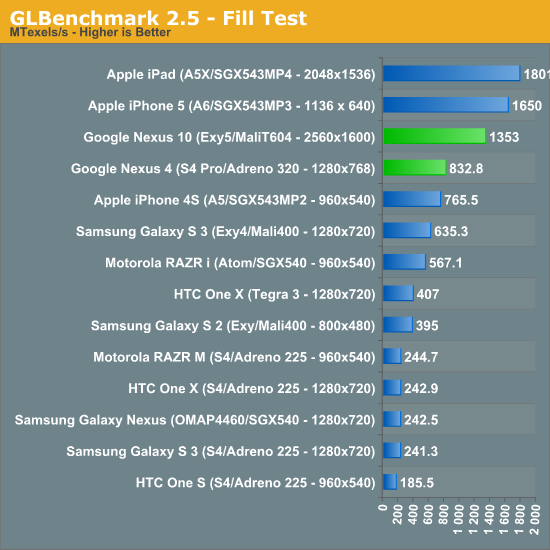
As far as raw fillrates are concerned, both Nexus devices do quite well here at their native resolutions. The iPad and iPhone 5 are both quicker, but we're still good gains over the previous generation of hardware - particularly for the Mali-T604. Compared to the Mali-400MP4 in the Galaxy S 3, we're seeing more than 2x the performance out of ARM's latest GPU.
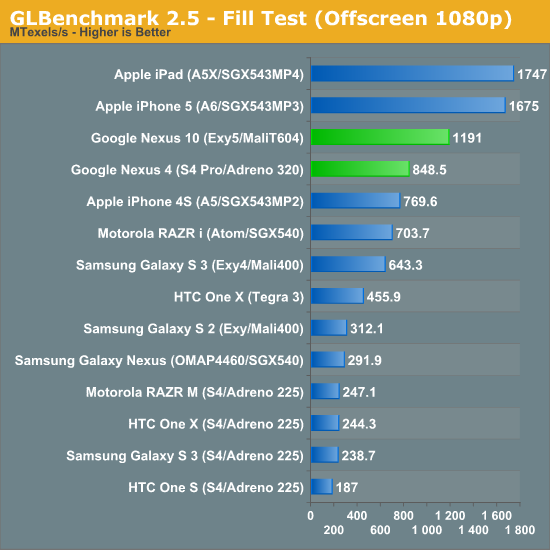
At normalized resolutions the standings don't really change.
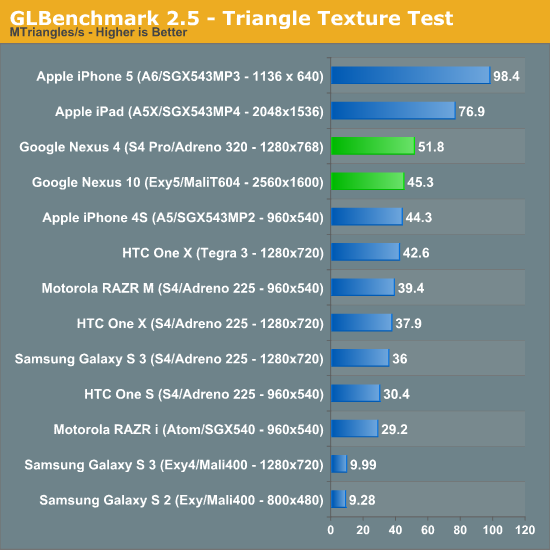
The T604 is ARM's first unified shader architecture, which gives it far more balanced pixel/vertex shader performance. The result is a more than 4x increase in triangle throughput compared to the Mali 400MP4. It's not enough to give the Nexus 10 the edge over the latest Apple devices, but it's a huge improvement over where ARM was in the previous generation. The Adreno 320 continues to be quite strong here as well.
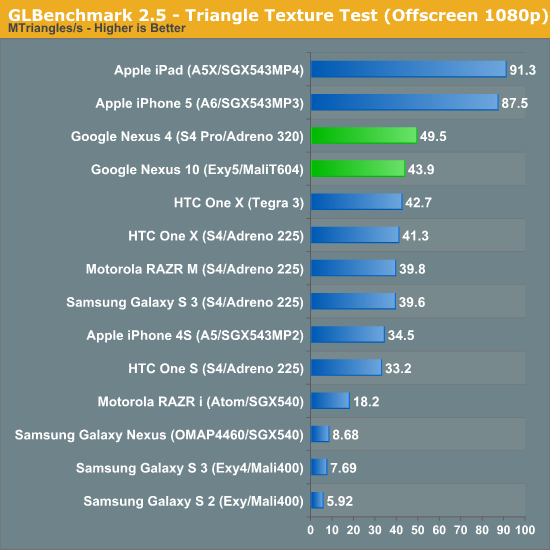
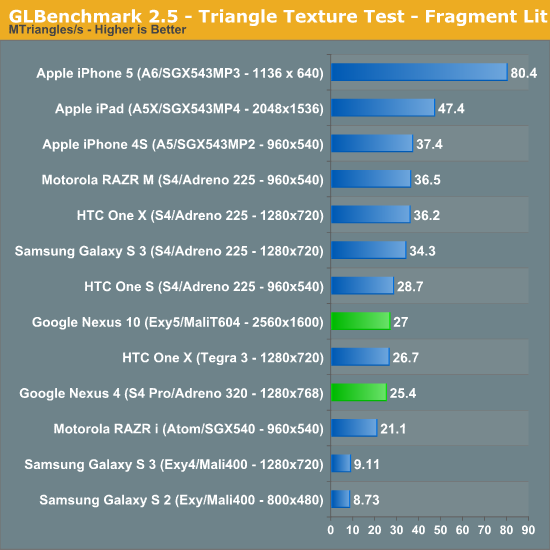
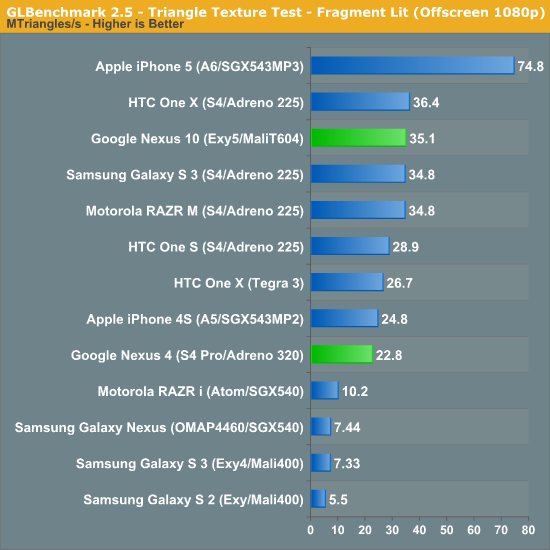
Once again we're seeing huge gains for the Mali-T604 compared to the Mali-400MP4. The Adreno 320 in the Nexus 4 actually performs worse than the Adreno 225 in older devices, possibly due to thermal throttling we saw on the Nexus 4 sample during periods of heavy load.
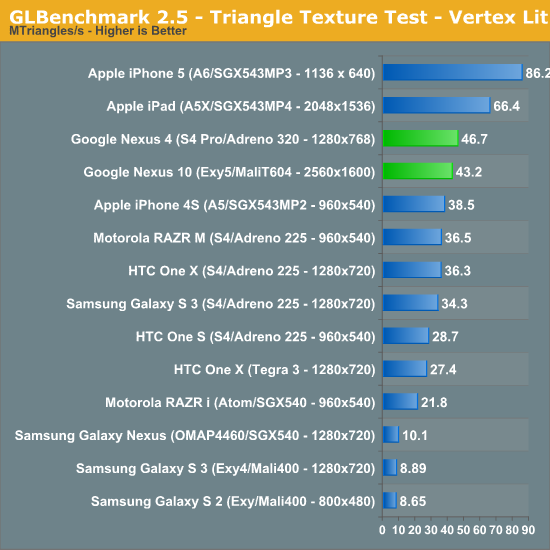
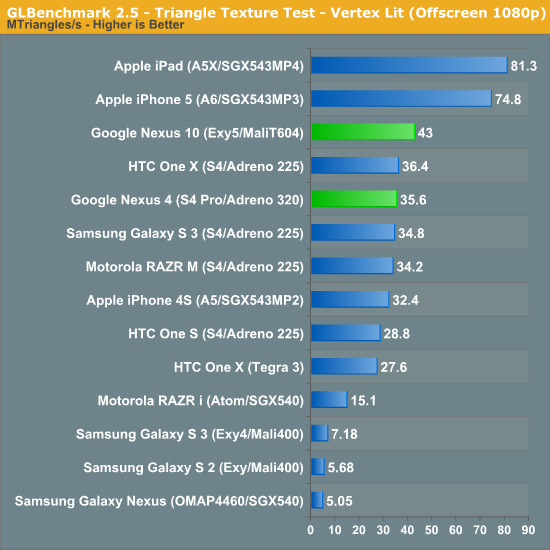
ARM shows the biggest gains here once again thanks to its move to a unified shader architecture. The Adreno 320 does ok here but it's really no better than the 225, I suspect there is some thermal throttling happening on the device.
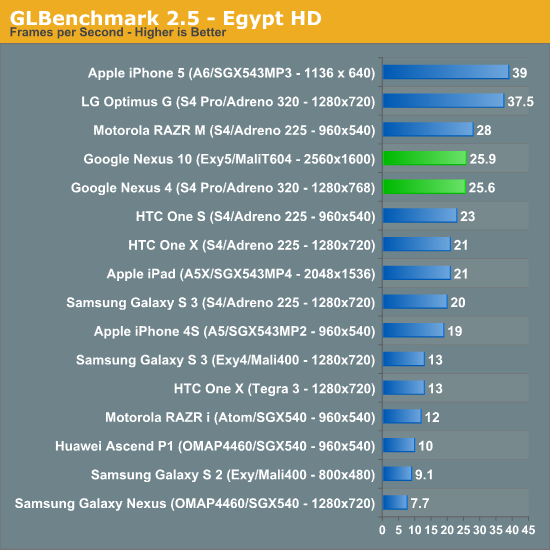
At native resolutions, the Nexus 10 and NExus 4 are both capable of putting out decent frame rates in Egypt HD. What this data tells us is they'll likely be able to run current and even some future titles, at native res, at 30 fps without much of an issue.
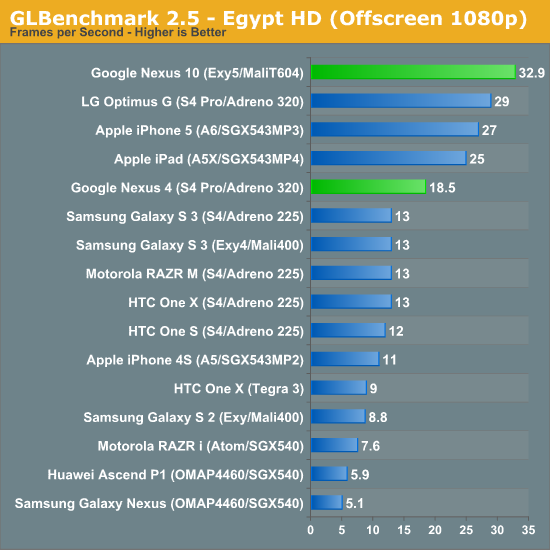
Normalize resolution and the Mali-T604 actually does very well here, setting a new performance record. Despite being based on the same hardware, the Optimus G is able to post a much higher score here than the Nexus 4. The explanation is simple: the Optimus G can't complete a single, continuous run of GLBenchmark 2.5 - the app will run out of texture memory and crash if you try to run through the entire suite in a single setting. The outcome is that the Optimus G avoids some otherwise nasty throttling. The Nexus 4 on the other hand manages to complete everything, but likely quickly throttles its clocks down due to thermal constraints. The Nexus 4 was really hot by the end of our GLBenchmark run, which does point to some thermal throttling going on here. I do wonder if the Snapdragon S4 Pro is a bit too much for a smartphone, and is better suited for a tablet at 28nm.
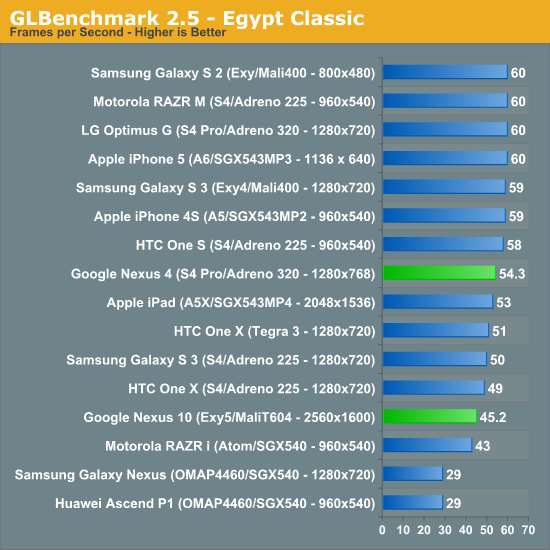
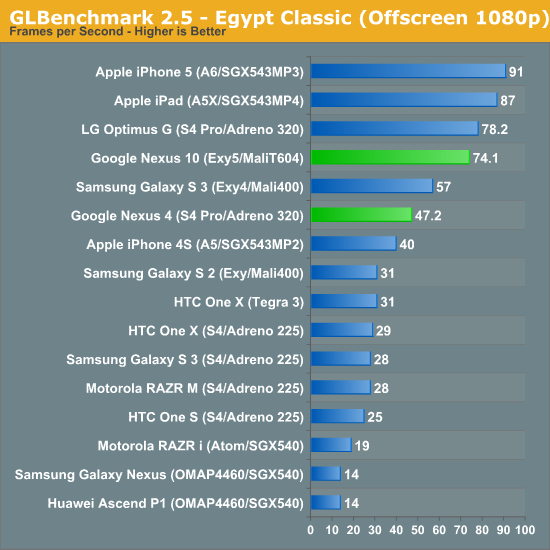
The Egypt Classic numbers are less interesting, but both platforms do well here.
Battery Life
We didn't have time to run through our entire battery life suite, but we do have some relevant results for the two devices. For smartphones, these are our latest web browsing battery life tests:
We regularly load web pages at a fixed interval until the battery dies (all displays are calibrated to 200 nits as always). The differences between this test and our previous one boil down to the amount of network activity and CPU load.
On the network side, we've done a lot more to prevent aggressive browser caching of our web pages. Some caching is important otherwise you end up with a baseband test, but it's clear what we had previously wasn't working. Brian made sure that despite the increased network load, the baseband still had the opportunity to enter its idle state during the course of the benchmark.
We also increased CPU workload along two vectors: we decreased pause time between web page loads and we shifted to full desktop web pages, some of which are very js heavy. The end result is a CPU usage profile that mimics constant, heavy usage beyond just web browsing. Everything you do on your smartphone ends up causing CPU usage peaks - opening applications, navigating around the OS and of course using apps themselves. Our 5th generation web browsing battery life test should map well to more types of smartphone usage, not just idle content consumption of data from web pages.
As always we test across multiple air interfaces (3G, 4G LTE, WiFi), but due to the increased network load we actually find that on a given process technology we see an increase in battery life on faster network connections. The why is quite simple to understand: the faster a page is able to fully render, the quicker all components can drive down to their idle power states.
All Android tests use Chrome and 5GHz WiFi unless otherwise listed.
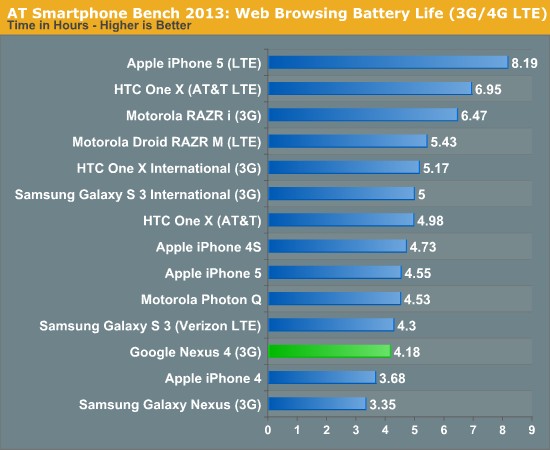
The Nexus 4 doesn't break any records for 3G battery life, it ends up relatively low on our list - even the Galaxy S 3 manages to do better here on 3G.

WiFi battery life is similar to the Galaxy S 3, but again it's not all that impressive compared to some of the other devices in this list.
Our tablet web browsing battery life test isn't directly comparable to the new smartphone tests, so we've got a separate chart for the Nexus 10:
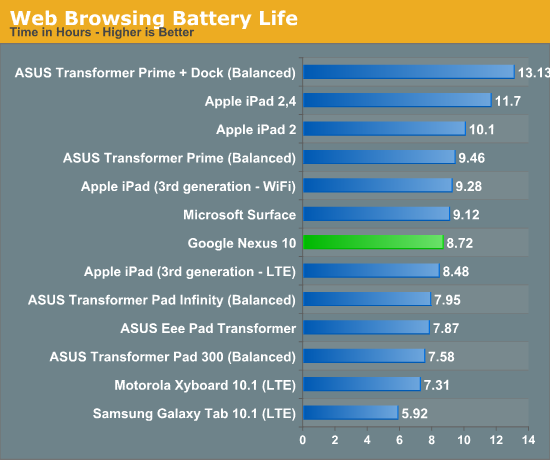
Despite driving a very high res panel, Google is able to deliver relatively competitive battery life with the Nexus 10. Battery capacity is around 80% the size of the 3rd gen iPad and battery life is around 93% of what Apple delivers here. Over 10 hours would be nice to have, but 8 hours of use in this test isn't bad at all. We'll have to do more testing to understand Exynos 5's power behavior a bit better, but so far it doesn't seem that the platform is all that bad from a power consumption standpoint. It remains to be seen how gracefully the Nexus 10 will handle being taxed heavier.
Display
We're still running our big display analysis routines on the new Nexus devices, but the brightness/contrast data below is a little teaser:
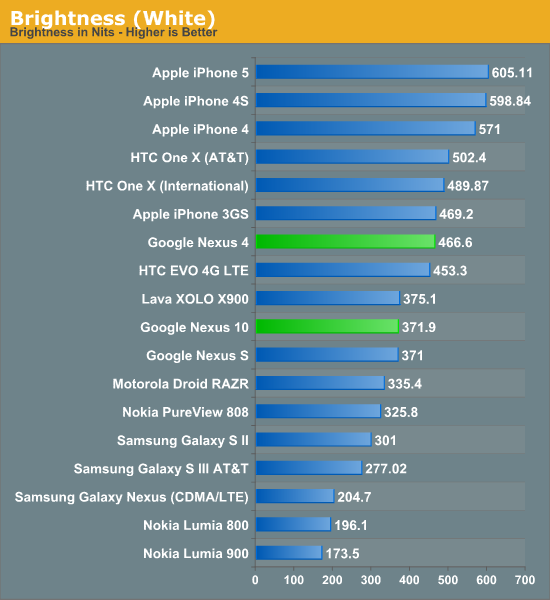
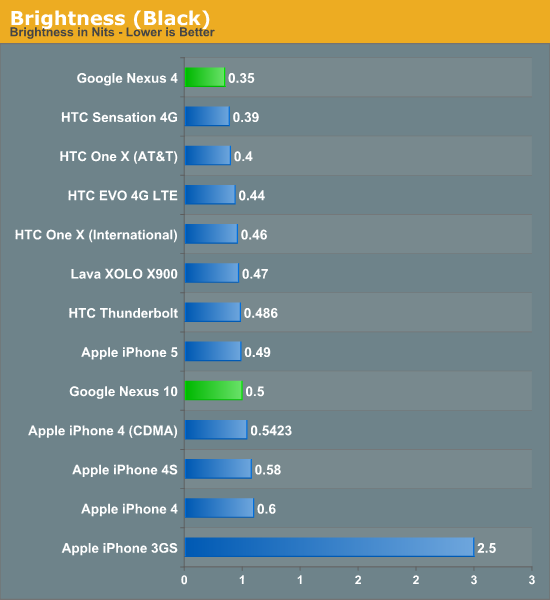
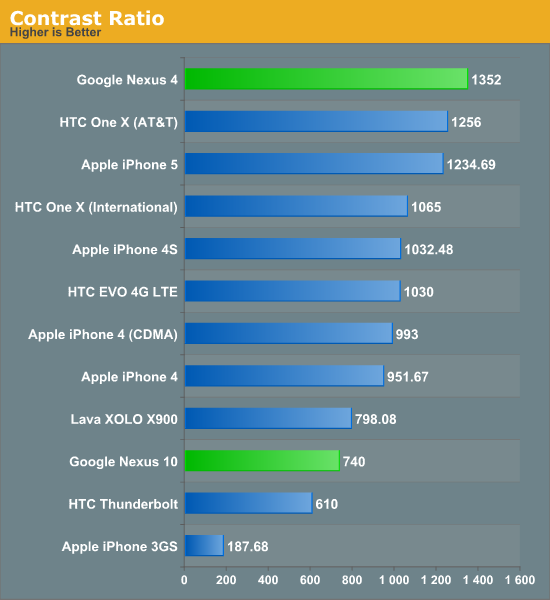
Final Words
We still have a lot of additional writing and testing ahead of us. Stay tuned for our full review of both devices!










244 Comments
View All Comments
blahsaysblah - Saturday, November 3, 2012 - link
I guess this may be a little late... Is there any performance difference because of the larger amount of flash storage? Is it like the SSD situation where there are more chips/channels/banks? I know I may be abusing terms.To be honest I would like to know if the 32 GB Nexus 7 is faster in real life situations as you swap between tasks as I do notice pauses here and there. Should I return my new 16? How about with Nexus 10s different storage sizes?
On side note, when will I be able to switch between tasks without them pausing. I am seriously thinking Win 8 will be only OS tablet that will let you multi task and have multiple windows open at same time. I seriously need Hulu app to keep running while ad runs while I switch to browser. Seems like space age stuff in comparison to my 4.1.2 Nexus 7 tablet... The 10 should at least have some kind of side by side mode in landscape and top bottom in portrait mode... Guess I should Google Ubuntu on Nexus to see what window manager is there, but than no netflix, hulu, apps. So toy like... yes this is my first tablet. All new to me.
tuxRoller - Saturday, November 3, 2012 - link
You shouldn't have slow downs while switching between tasks in the Nexus 7. That is mostly a RAM/CPU issue and the Nexus 7 has plenty of both. However, if you can't wait for the AT review, theverge reviews the Nexus 10. They say there are no slow downs. It also has twice the RAM of the Nexus 7.nickfer - Saturday, November 3, 2012 - link
What this review of benchmarks doesn't specify is the pre-release version of Android 4.2 that has been used. All reviews I have seen have the Nexus 4 using a kernel 3.4.0, while the Nexus 10 using a kernel 3.4.5. I am not sure if this applies to the units tested here, but I wonder if the same builds were used on both devices. This could go a long way in explaining the results. And in general, for any "scientific" benchmarking, I would expect those details to be listed, something that cannot be said for this review.Zodiark1593 - Saturday, November 3, 2012 - link
Soo, there's talk of these fantastic displays for tablets and other such gadgets, but where's these mythical LCDs for laptops? The only one I've seen would be on the Macbook family, but I'm looking for a gamer, not a fashion statement, and a gaming laptop would certainly be better equipped for such displays.It kinda makes me mad that a tablet would have a significantly better display than a multi-grand gaming laptop.
rahuldesai - Saturday, November 3, 2012 - link
Hi Anand,Could you explain in what sense the Optimus G and Nexus 4 differ wrt to the below statement:
"the Optimus G can't complete a single, continuous run of GLBenchmark 2.5 - the app will run out of texture memory and crash if you try to run through the entire suite in a single setting. The outcome is that the Optimus G avoids some otherwise nasty throttling. The Nexus 4 on the other hand manages to complete everything, but likely quickly throttles its clocks down due to thermal constraints"
tytung - Saturday, November 3, 2012 - link
I had high hopes for Note 10 - amazing resolution and latest processor from Samsung, plus buttery smooth UI.Sadly, in almost all of the benchmarks here the top is always iPad 3 and iPhone 5. Not to mention the latest iPad 4 is even powerful than iPad 3.
Looks like iPad 4 and iPhone 5 are the most powerful devices out there, end of story.
UpSpin - Saturday, November 3, 2012 - link
No.If you take a look at the browser benchmark, you'll notice that the iPads are missing! Why, because they score worse than the Nexus 10. Because the Nexus 4 scores miserably compared to the identical LG Optimus G (which are missing on AT again), with the exception that the LG runs on ICS, we can safely assume that the used browser is responsible for the bad ratings and with a software update the results will, additionally, for the Nexus 10, too, greatly improve.
If you take a look at the GPU benchmark and exclude those meaningless synthetic benchmarks which can easily get manipulated or at least don't say anything about the real performance of the GPU, and compare the 3D scene benchmarks which the user will later experience then the Nexus 10 outscores the iPad 3. In Offscreen it's even the fastest. In the classic benchmark both hit 60FPS, so the classic benchmark became obsolete.
I still think the Nexus 4 numbers are flawed (maybe defective device with a bad SoC or other issues) because the Optimus G (the same device!!) scores much better, even better than the iPhone 5.
However, the iPad 4 will be much faster than the Nexus 10 in GPU power, no question.
doobydoo - Sunday, November 4, 2012 - link
Yeah, comparing new device vs new device, the Nexus 10 is miles behind the iPad 4, in both CPU and GPU.That's very disappointing. Even the iPhone 5 beats it in many of the actual rendering tests.
joelol75 - Sunday, November 11, 2012 - link
Bit of a non-issue for iOS users since their stock browser consistently dominates......because you didn't want to hear the fact that the already-out iPad will surpass this in performance by a long way...comparing new device vs new device, the Nexus 10 is miles behind the iPad 4...1. Would U please shut up! I have an idea. Anatech Stop listing Apple benchmarks in Android reviews so AppFboiz like you stop posting your crAPPaganda. I love the "ummm. I guess Nexus x sucks so I'm getting the Iphone" posts too. Either these fb's have icrap hardware and a Steve Jobs candlelit shrine already or they really are that stupid (in that case they are making the right choice)
NO! Android users don't bail to Apple on a review (maybe decide between other Android devices) so quit posting this crap. I don't post Android propaganda on Apple review sites and personally prefer it if Nokia STOOD BEHIND Maemo instead of flushing their business down the Symbian and Microsoft tubes but anyway the point....
The Nexus . IS new software as well as hardware. Show me a phone with 4.2 on it... and.... the new Iclone is just rehashed same-old, cookie-cutter, designed for obsolescence in no time Apple hardware with an old lock-me-in-Johnny, I-so-stupid so show me how (rather tell me how) to use my device shiny GUI on top of a good (which they didn't write of course but legally stole) FreeBSD OS known as IOS6.
I'm retiring or promoting my Nokia N900 to a carputer project so I can remote start my car by Wifi, SMS, or SSH. It will have a Nexus10 integrated into the dash replacing the Factory radio and will have a Stripped Dell Pentium M laptop with Linux for the backend. All HVAC controls will be touch controlled. Blower motor will be PWM Mosfet. Remote entry will be RFID, NFC (Samsung Tectiles), or SSH. (Solenoid door poppers). Wifi hotspot and GPS, Bluetooth tether and other display duties (FM RDS) will be handled by the N900. Wifi linking and media sync (podcasts auto dl'd) and video capture from the 4 always running cameras as well as OBD2 datalogging (ELM327), voice control and text to speech will be all Linux (ATT Truevoice or Cepstral) Smb and Nfs will be available as the car will always be wifi hs will be handled by a Raspberry Pi and GPIO for all this (no keys! power seat /mirror. memory and other logic will be PicAxe handled. Some voice prompts will be handled with WinBond ISD1000 or so series chips. Radio tuning and rds by si474 ics.
Anyway id rather use my old Nokia N900 than get a ip6. I was deciding btw nexus . and sgs3. Maybe Note 2. Sooo. someone like me would use the iphone as a paperweight. The sheep like 'em I hear...
Sind - Saturday, November 3, 2012 - link
It's apparent from the vastly different review results popping up on the internet that different phones are running different versions. I'm not sure why google is allowing the reviews before the 13th or when the final build is released, but with such obvious benchmark discrepancies and battery life being vastly different from site to site something isn't jiving and frankly your doing a disservice to consumers by not waiting.